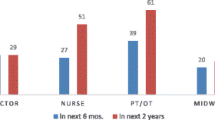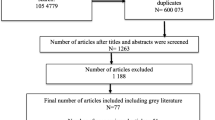Abstract
Using a multi-stage cluster sampling approach, we collected healthcare and demographic data from 531 migrants and 529 local urban residents aged 16–64 in Shanghai, China. Logistic regressions were used to analyze the relationship between gender-migration status and healthcare utilization while controlling for predisposing, enabling and needs factors. Other things equal, female migrants and male locals had significantly lower actual healthcare utilization rates, compared to female locals. Female migrants were more likely to report “no money” as a reason for not seeking care, while male locals were more likely to report “self-medication” as a reason. Considering established gender differences in healthcare utilization, we conclude that female migrants as a group face the most healthcare access barriers among all groups.

Similar content being viewed by others
References
Aday, L. A., & Andersen, R. M. (2005). Models of health care utilization and behavior. Encyclopedia of Biostatistics. Wiley.
Bertakis, K. D., Azari, R., Helms, L. J., Callahan, E. J., & Robbins, J. A. (2000). Gender differences in the utilization of health care services. Journal of Family Practice, 49(2), 147–152.
Blumenthal, D., & Hsiao, W. (2005). Privatization and its discontents—The evolving Chinese health care system. New England Journal of Medicine, 353(11), 1165.
Central Intelligence Agency. (2011). The world fact book, from https://www.cia.gov/library/publications/the-world-factbook/geos/ch.html
Chan, K. W., & Zhang, L. (1999). The hukou system and rural-urban migration in China: Processes and changes. The China Quarterly, 160, 818–855.
Donato, K. M., Gabaccia, D., Holdaway, J., Manalansan, M., & Pessar, P. R. (2006). A glass half full? Gender in migration studies. International Migration Review, 40(1), 3–26.
Fan, C. C. (2003). Rural urban migration and gender division of labor in transitional China. International Journal of Urban and Regional Research, 27(1), 24–47.
Feng, W., Ren, P., Shaokang, Z., & Anan, S. (2005). Reproductive health status, knowledge, and access to health care among female migrants in Shanghai, China. Journal of Bosocial Science, 37(05), 603–622.
Fry, R. A., & Center, P. H. (2006). Gender and migration. Pew Hispanic Center.
Hesketh, T., Jun, Y., Lu, L., & Mei, W. (2008). Health status and access to health care of migrant workers in China. Public Health Reports, 123(2), 189.
Hibbard, J. H., & Pope, C. R. (1983). Gender roles, illness orientation and use of medical services. Social Science and Medicine, 17(3), 129–137.
Hondagneu-Sotelo, P., & Cranford, C. (2006). Gender and migration. Handbook of the sociology of gender, pp. 105–126.
Hong, Y., Li, X., Stanton, B., Lin, D., Fang, X., Rong, M., et al. (2006). Too costly to be ill: Health care access and health seeking behaviors among rural-to-urban migrants in China. World Health & Population, 8(2), 22.
Jasso, G., Massey, D. S., Rosenzweig, M. R., & Smith, J. P. (2004). Immigrant health selectivity and acculturation. In N. B. Anderson, R. A. Buatao, & B. Cohen. (Eds.), Critical perspectives on racial and ethnic differences in health in late life (pp. 227–266). Washington, DC: The National Academies Press.
Lee, M. H. (2011). The one-child policy and gender equality in education in China: Evidence from household data. Journal of Family and Economic Issues, Online First,. doi:10.1007/s10834-011-9277-9.
Li, X., Stanton, B., Chen, X., Hong, Y., Fang, X., Lin, D.,… Wang, J. (2006). Health indicators and geographic mobility among young rural-to-urban migrants in China. World Health & Population, 8(2), 5.
Liu, Y., Hsiao, W. C., & Eggleston, K. (1999). Equity in health and health care: The Chinese experience. Social Science and Medicine, 49(10), 1349–1356.
Long, Q., Li, Y., Wang, Y., Yue, Y., Tang, C., Tang, S.,… Tolhurst, R. (2008). Barriers to accessing TB diagnosis for rural-to-urban migrants with chronic cough in Chongqing, China: A mixed methods study. BMC Health Services Research, 8(1), 202.
Lu, Z., & Song, S. (2006). Rural-urban migration and wage determination: The case of Tianjin, China. China Economic Review, 17(3), 337–345.
Mou, J., Cheng, J., Zhang, D., Jiang, H., Lin, L., & Griffiths, S. M. (2009). Health care utilisation amongst Shenzhen migrant workers: Does being insured make a difference? BMC Health Services Research, 9(1), 214.
Mustard, C. A., Kaufert, P., Kozyrskyj, A., & Mayer, T. (1998). Sex differences in the use of health care services. New England Journal of Medicine, 338(23), 1678.
National Bureau of Statistics of China. (2010). China statistics yearbook 2010. China Statistics Press.
Peng, Y., Chang, W., Zhou, H., Hu, H., & Liang, W. (2010). Factors associated with health-seeking behavior among migrant workers in Beijing, China. BMC Health Services Research.
SAS Institute Inc. (2011). SAS Software (Version 9). Cary, NC. Retrieved from www.sas.com
Shaokang, Z., Zhenwei, S., & Blas, E. (2002). Economic transition and maternal health care for internal migrants in Shanghai, China. Health Policy and Planning, 17(Suppl 1), 47.
Shi, L. (1993). Health care in China: A rural-urban comparison after the socioeconomic reforms. Bulletin of the World Health Organization, 71(6), 723.
Swain, L. L., & Garasky, S. (2007). Migration decisions of dual-earner families: An application of multilevel modeling. Journal of Family and Economic Issues, 28(1), 151–170.
Verbrugge, L. M., & Wingard, D. L. (1987). Sex differentials in health and mortality. Women and Health, 12(2), 103–145.
Wang, Y., Long, Q., Liu, Q., Tolhurst, R., & Tang, S. (2008). Treatment seeking for symptoms suggestive of TB: Comparison between migrants and permanent urban residents in Chongqing, China. Tropical Medicine & International Health, 13(7), 927–933.
Wei, X., Chen, J., Chen, P., Newell, J. N., Li, H., Sun, C.,… Walley, J. D. (2009). Barriers to TB care for rural-to-urban migrant TB patients in Shanghai: A qualitative study. Tropical Medicine & International Health, 14(7), 754–760.
Wen, M., Fan, J., Jin, L., & Wang, G. (2010). Neighborhood effects on health among migrants and natives in Shanghai, China. Health & Place, 16(3), 452–460.
Yang, X., & Guo, F. (1999). Gender differences in determinants of temporary labor migration in China: A multilevel analysis. International Migration Review, 33(4), 929–953.
Yang, H., Li, X., Stanton, B., Chen, X., Liu, H., Fang, X.,… Mao, R. (2005). HIV-related risk factors associated with commercial sex among female migrants in China. Health Care for Women International, 26(2), 134–148.
Yang, X., & Xia, G. (2006). Gender, migration, risky sex, and HIV infection in China. Studies in Family Planning, 37(4), 241–250.
Zhang, W. (2001). Building for future: The social and financial structure needed to provide effective and affordable care. Paper presented at the Symposium at the Health Care, East and West, Moving into the 21st Century Conference, Boston, MA.
Acknowledgments
This study was jointly sponsored by the University of Utah, The Chinese University of Hong Kong and Fudan University. The authors thank Xiaoxin Su for her valuable research assistance.
Author information
Authors and Affiliations
Corresponding author
Rights and permissions
About this article
Cite this article
Fan, J.X., Wen, M., Jin, L. et al. Disparities in Healthcare Utilization in China: Do Gender and Migration Status Matter?. J Fam Econ Iss 34, 52–63 (2013). https://doi.org/10.1007/s10834-012-9296-1
Published:
Issue Date:
DOI: https://doi.org/10.1007/s10834-012-9296-1




